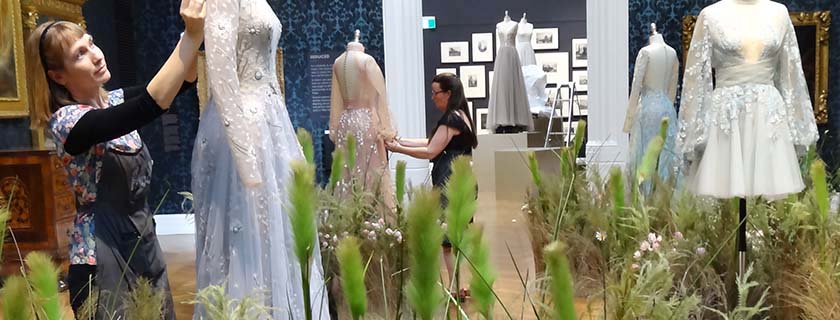 Installation and exhibition preparation, Paolo Sebastian: X, Art Gallery of South Australia, Adelaide
Installation and exhibition preparation, Paolo Sebastian: X, Art Gallery of South Australia, Adelaide
Textiles are extremely fragile and require specialised care and treatment to ensure they are preserved, enriching our lives and those of future generations. Our passion, knowledge and curiosity about textiles allows us to assist owners and curators to learn more about the textiles in their collections.
Textiles are complex objects and can be made from multiple natural and synthetic materials, all of which age and behave differently.
We treat costumes, flags, banners, soft furnishings, embroideries and samplers, carpets, tapestries, ecclesiastical textiles, soft toys, christening gowns, sporting memorabilia, wedding dresses, quilts, contemporary art, military uniforms, ethnographic textiles and theatre costumes. Our conservators also provide storage and treatment plans for clients to achieve positive outcomes for the conservation of textile collections.
A textile may simply require safe storage to ensure its preservation or it may need a full treatment including examination, analysis, identification of materials, wet or dry cleaning, support and extensive stitching or adhesive restoration and mounting for display. Each treatment is determined by the specific needs of the textile, with options designed to suit the client’s needs and the different outcomes for each option clearly explained.
Artlab has one of the best facilities in Australia for large and complex textile treatments. We have developed specific equipment to manage the health and safety risks inherent in textile conservation, which has now become standard practice for conservators. This allows us to safely treat significant textiles such as the very large Eureka Flag – the Flag’s extensive treatment included over 300 hours of meticulous stitching under a tight timeline with strict requirements for security. Our experience working with large items, our versatile staff and secure building enable us to successfully undertake the most challenging conservation projects.
We have had similar achievements conserving culturally significant textiles overseas. Our conservators had the privilege of preserving the assassination garments worn by Indira and Rajiv Gandhi. Treatment was undertaken at the Indira Gandhi Memorial Museum in New Delhi, requiring us to provide all materials and equipment to work onsite to stabilise the garments for posterity.
Conservation projects are carefully developed to meet the specific and varied needs of our clients. One project in Penang, Malaysia, involved us working in partnership with Georgetown World Heritage Inc to deliver textile conservation capacity building training. We trained local Penang-based staff and volunteers to carry out the extensive conservation stitching required to treat a fragile Chinese temple banner. We have also delivered training for textiles conservation, exhibition preparation, preventive conservation and disaster preparedness in Indonesia, India, East Timor and Malaysia.


